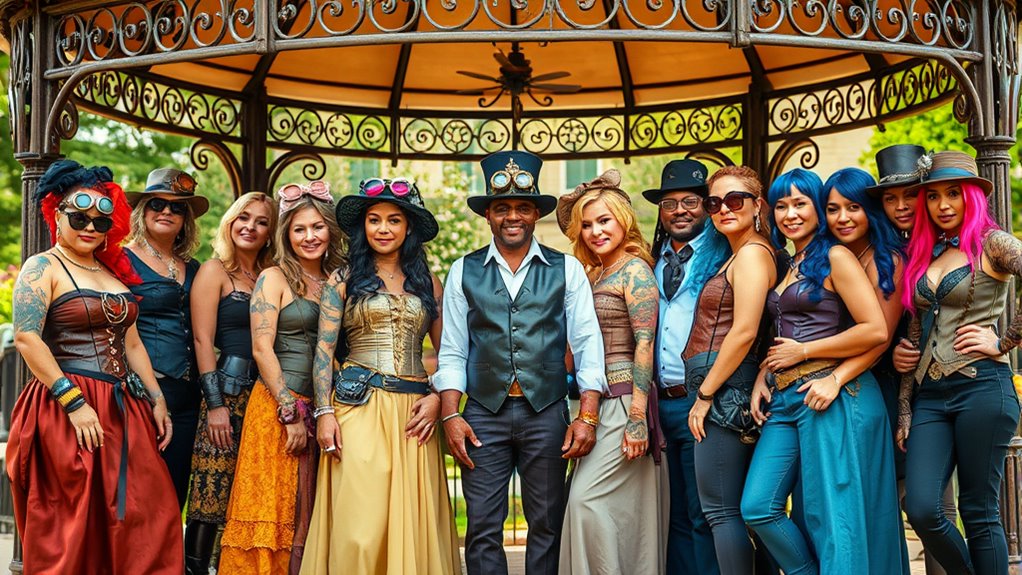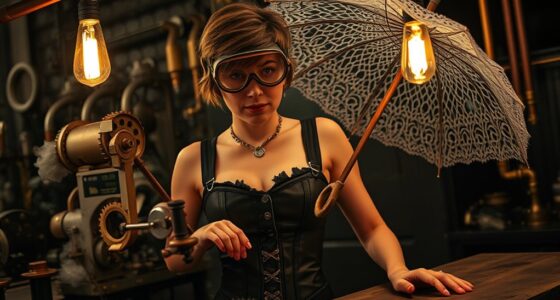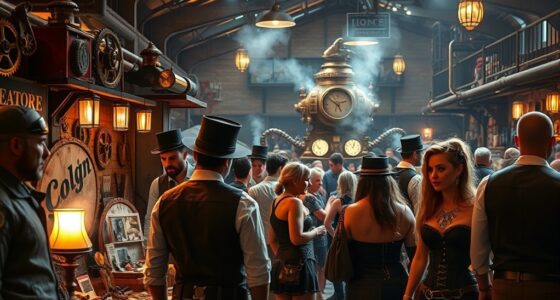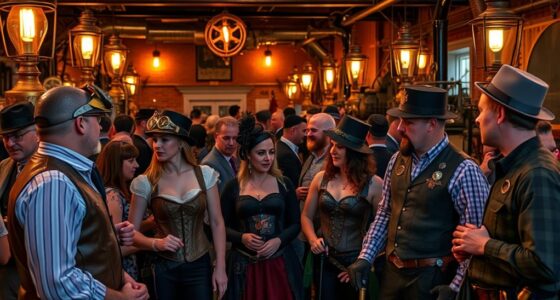In today’s steampunk world, inclusivity is shaping the genre by celebrating diverse cultures, gender identities, and unique expressions. You’ll see costumes and stories that go beyond traditional Victorian themes, highlighting Asian, African, Indigenous influences, and non-binary characters. This shift creates a more welcoming, authentic environment that reflects our diverse society. If you want to explore how this vibrant evolution is transforming the neo-Victorian landscape, there’s much more to discover.
Key Takeaways
- The genre now incorporates diverse cultural elements, reflecting Asian, African, and Indigenous influences in costumes and world-building.
- Contemporary narratives highlight strong, complex female, non-binary, and genderqueer characters, challenging traditional gender stereotypes.
- Costume designs emphasize gender fluidity and non-conformity, using androgynous styles and inclusive visuals.
- Increased diversity promotes authentic storytelling, celebrating multiple perspectives and expanding creative possibilities within steampunk.
- The evolution fosters a more inclusive, welcoming community, ensuring the genre remains vibrant, relevant, and accessible for future generations.

Have you ever wondered how steampunk, a genre known for its Victorian-inspired aesthetics and retro-futuristic themes, is evolving to become more inclusive? Traditionally, steampunk has often centered around a narrow view of history, predominantly reflecting Western European cultures and often portraying gender roles in stereotypical ways. But today, creators and fans are actively working to expand its scope, emphasizing cultural representation and gender diversity. This shift isn’t just about adding more characters; it’s about reshaping the genre’s foundation to welcome a broader range of identities and experiences.
Steampunk is evolving to embrace cultural diversity and challenge gender stereotypes, reshaping its Victorian-inspired roots.
You’ll notice that contemporary steampunk stories and designs are increasingly featuring characters from diverse cultural backgrounds. This isn’t just about superficial inclusion but about genuinely integrating different cultural perspectives into the aesthetic and narrative fabric of the genre. For example, some artists incorporate elements from Asian, African, or Indigenous cultures into their costumes and world-building, creating a richer, more authentic tapestry that resonates beyond the traditional Victorian Eurocentric focus. This broadening of cultural representation allows fans from various backgrounds to see themselves reflected within the genre, fostering a more welcoming and inclusive community.
Gender diversity is also gaining prominence in steampunk. The genre historically leaned toward a male-dominated perspective, with women often relegated to secondary roles or romantic interests. Today, however, there’s a conscious effort to challenge these stereotypes by featuring strong, complex female characters and emphasizing non-binary and genderqueer identities. You might see stories where women are inventors, engineers, or leaders, breaking away from traditional gender roles. These narratives not only diversify the genre but also inspire a sense of empowerment, encouraging everyone to see themselves as part of this neo-Victorian world.
Creators are also rethinking costume design and visual aesthetics to reflect gender fluidity and non-conformity. Costumes are no longer bound by rigid gender norms; instead, they blend elements traditionally associated with different genders or experiment with androgyny. This visual shift signals to audiences that steampunk is a space for all identities, not just the historically stereotypical ones. Moreover, some creators are exploring inclusive design principles to make costumes and environments more accessible and representative of various body types and abilities.
Ultimately, these efforts to promote cultural representation and gender diversity are transforming steampunk into a more inclusive genre. Whether through storytelling, art, or cosplay, the focus is on celebrating a multitude of perspectives and experiences. By doing so, steampunk not only becomes more reflective of our diverse world but also inspires others to imagine new possibilities within its neo-Victorian universe. This evolution is crucial for keeping the genre vibrant, relevant, and welcoming for everyone willing to explore its inventive, boundary-pushing landscape.
Frequently Asked Questions
How Can Steampunk Events Be More Accessible to Disabled Participants?
You can make steampunk events more accessible by providing adaptive seating options and ensuring all areas have clear, accessible signage. Consider ramps and elevators for different mobility needs, and train staff to assist disabled participants effectively. Additionally, offer quiet zones and sensory-friendly spaces. These steps help create an inclusive environment, allowing everyone to enjoy the creativity and camaraderie of steampunk culture fully.
What Are Some Common Cultural Missteps in Steampunk Inclusivity Efforts?
You might not realize that 60% of steampunk events have faced criticism for cultural missteps. Common issues include cultural appropriation, where elements are used without understanding, and stereotype reinforcement, which can alienate communities. To avoid these, you should research origins thoroughly and respect diverse cultures. Being mindful prevents reinforcing stereotypes and promotes genuine inclusivity, making your events welcoming for everyone and enriching the steampunk community.
How Can Steampunk Communities Promote Gender Diversity Effectively?
To promote gender diversity effectively, you should focus on enhancing gender representation within your community and encouraging inclusive storytelling. Support diverse voices by featuring creators of different genders and backgrounds, and create spaces where everyone feels comfortable sharing their perspectives. By actively challenging stereotypes and celebrating varied identities, you help build a more welcoming steampunk scene that truly reflects the richness of all its members.
Are There Specific Steampunk Subgenres That Emphasize Inclusivity?
Did you know that some steampunk subgenres actively promote inclusivity? Subgenres like queer steampunk or Afro-futurist steampunk emphasize alternative narratives and cultural representation, highlighting marginalized voices. These communities challenge traditional Victorian norms by celebrating diversity through storytelling, fashion, and art. If you seek a more inclusive experience, exploring these niche areas can help you connect with a broader, more representative steampunk world that values every voice.
How Does Inclusivity Impact the Historical Authenticity of Steampunk?
You might wonder how inclusivity impacts steampunk’s historical accuracy and cultural authenticity. Embracing diverse perspectives enriches the genre, fostering a more authentic reflection of varied histories and cultures. While some argue it challenges traditional notions of authenticity, it actually broadens the narrative scope, making steampunk more relatable and genuine. By integrating diverse voices, you help create a more inclusive, vibrant world that respects history’s complexity without sacrificing creative imagination.
Conclusion
By embracing diversity within the steampunk world, you help create a richer, more authentic universe that welcomes everyone. Your choices can challenge stereotypes and open doors for new stories and perspectives. Isn’t it time to reimagine this neo-Victorian landscape as a space where all voices are heard and celebrated? When you prioritize inclusivity, you not only expand the genre but also inspire others to imagine a future where everyone belongs.









